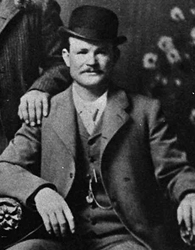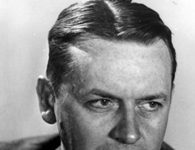Butch Cassidy was a famed outlaw in the dying days of the Old West, leading the Hole-in-the-Wall Gang and the Wild Bunch in daring robberies of banks and trains. Cassidy earned the reputation as the Robin Hood of the West, a gentleman bandit who stole only from the rich and claimed to have never killed a man.
Butch Cassidy’s Early Days
Butch Cassidy was born Robert Leroy Parker on April 13, 1866, in Beaver, Utah. The first of 13 children born to Maximillian Parker and Ann Gillies, two Mormon immigrants from Britain, Roy grew up working on his family’s ranch.
He had his first brush with the law as a teenager when he broke into a closed clothing store, took a pair of jeans, and left an IOU note; he was arrested, but served no prison time.
When his father lost his land, Roy began working for rancher Mike Cassidy, who taught Roy to rustle cattle and use guns. In 1884, the 18-year-old Roy Parker, who had already begun rustling cattle, left Utah for Telluride, Colorado, where he would begin his life as an outlaw.
Sources in this Story
- Utah.com: History of Butch Cassidy, LeRoy Parker
- Climb-Utah.com: Robbers Roost History
- True West Magazine: Following the Wild Bunch
- HistoryNet (Wild West): Butch Cassidy’s Surrender Offer
- HistoryNet (Wild West): The Last Days of Butch Cassidy and the Sundance Kid
- Utah.gov: Utah History to Go: The Myths and Legends of Butch Cassidy
Cassidy’s Notable Accomplishments
For the next few years Parker was a migrant cowboy and small-time outlaw who had several run-ins with the law for cattle rustling. During this time he took the name “Butch Cassidy,” likely in honor of Mike Cassidy.
Cassidy’s first major crime is believed to have occurred on June 24, 1889, when he and two other men robbed over $20,000 from a Telluride bank. Cassidy would gain a reputation as a “Robin Hood” of the West, stealing from banks, trains and large cattle companies.
He was “an outlaw fighting for ‘settlers rights, as citizens of the united States of America against the old time cattle baron (sic)’ as written in a mysterious manuscript now believed to be Roy Parker’s memoir,” according to Utah.com.
Cassidy’s gangs had several hideouts along the Outlaw Trail, including Robbers’ Roost, a secluded area in southeastern Utah, and the Hole-in-the-Wall, a canyon in Wyoming accessible only through a narrow pass.
The podcast “Stuff You Missed In History Class” has an episode on Robbers’ Roost.
After spending a year and a half in prison for cattle rustling, Cassidy formed a gang known as Butch Cassidy’s Wild Bunch, which included Elza Lay, News Carver, Tall Texan, Kid Curry and Harry Longabaugh, better known as the “The Sundance Kid.” The Wild Bunch robbed many banks and trains over the next three years until Lay was arrested and imprisoned for killing a sheriff.
Having lost his right-hand man, Cassidy sought clemency for his crimes, insisting that he had never killed a man and had targeted companies rather than individuals. However, he was unable to reach a deal with either the governor of Utah or the Union Pacific railroad.
He returned to train robbing, this time with the Sundance Kid as his main accomplice. With each successive heist, the authorities closed in on Cassidy and Sundance; they, along with Sundance’s common-law wife, decided to leave the country for Argentina in 1902, ending Cassidy’s career as the West’s most famous outlaw.
The Man and His Work
- “The Outlaw Trail: A History of Butch Cassidy and His Wild Bunch,” by Charles Kelly
- “In Search of Butch Cassidy,” by Larry Pointer
- “Digging up Butch and Sundance,” by Anne Meadows
- “Butch Cassidy: A Biography,” by Richard Patterson
- “Butch Cassidy and the Sundance Kid” (DVD)
The Rest of the Story
After several years working as ranchers, Cassidy and the Sundance Kid began robbing banks in South America. In November 1908, after robbing a courier, the two were traced to a small house in San Vincente by local authorities and attacked during the night.
The following morning, the two were found dead. “From the positions of the bodies and the locations of the fatal wounds, the witnesses apparently concluded that Butch had put his partner out of his misery, then turned the gun on himself,” wrote Anne Meadows and Daniel Buck in Wild West magazine.
Town authorities were unsure of who the two men were and buried them in a local cemetery. They were never reliably identified and there are many legends that Butch Cassidy was not killed in Bolivia, but in fact returned to America years later. Lula Parker Betenson, Butch’s youngest sister, insisted that Cassidy had returned and visited the family.
Cassidy was immortalized in the 1969 film “Butch Cassidy and the Sundance Kid” starring Paul Newman as Cassidy and Robert Redford as the Sundance Kid.
This article was originally written by Denis Cummings; it was updated March 8, 2017.











